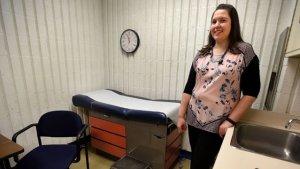
Nurse practitioner program in high schools secures new funding

Kaeli Cochrane is a nurse practitioner working at two downtown high schools, Sir John A. Macdonald and Cathedral. Photo: Barry Gray,The Hamilton Spectator
Joanna Frketich
Hamilton Spectator | Feb 13, 2017
Hundreds of Hamilton’s most vulnerable teens have visited a nurse practitioner right in their high school.
The program at Sir John A. Macdonald Secondary School and Cathedral High School has been quiet about its success for the last four years because it was always in danger of shutting down.
It could not get dedicated funding despite a wide variety of health and community organizations agreeing a nurse practitioner was desperately needed in the high schools of the city’s poorest neighbourhoods with high newcomer and aboriginal populations.
The Hamilton Community Foundation gave what cash it could to the program. It also had support from McMaster University’s school of nursing and Refuge: Hamilton Centre for Newcomer Health.
But many times, Good Shepherd Centre had to find ways to keep it running with no funding at all.
“We’ve been functioning on a crisis basis,” said Peter Kibor, director of Good Shepherd Centre Shelter Health Network Medical Clinics. “Are we going to get by to the next semester? We’ve not been able to reach out and tell our story because we’ve been trying to survive.”
The hours the nurse practitioner could spend at each school bounced from four to eight a week depending on what money the program could cobble together.
“If I was scheduled for four hours, I’d often spend six to eight,” said nurse practitioner Hallie Streith. “I didn’t want kids not to be seen.”
All the while, the number of visits to the nurse climbed to 416 in 2015 from 328 in 2013.
Over three years, there have been more than 1,000 visits.
There is no way to measure how many more stopped by to find the clinic was closed.
“There are always students there,” said Judith Bishop, chair of the Hamilton School Based Health Network. “We don’t know how big the need is.”
For the first time since opening their doors in the fall of 2012, the school clinics can finally stop worrying about where the next dollar is coming from and focus instead on major expansion.
The Hamilton Niagara Haldimand Brant Local Health Integration Network has agreed to spend $130,000 a year on the program. It will allow the nurse practitioner to spend three full days a week at Sir John A Macdonald and two days at Cathedral.
It is expected to make a big difference for students and their families.
“You can get the individual at a stage when intervention can be provided,” said Kibor. “You can change the trajectory of their life.”
One in five students who came to the nurse practitioner in 2015 had mental health issues, although that was often not the main reason for the visit.
One in seven had a gynecological problem. One in 10 came for dermatology help or musculoskeletal injuries. Others sought help with asthma, headaches, sleep problems, weight-loss advice, dental issues, smoking cessation and a wide variety of other health concerns.
Without the nurse practitioner, many would have ended up visiting a hospital. North Hamilton youth aged 10 to 24 make up more than one-third of the city’s emergency department and urgent care visits for this age group.
At least one-third of the students have no family doctor.
“We can’t turn a blind eye and pretend it’s life as usual,” said Kibor. “There is poverty and other challenges. We’re dealing with a high-needs neighbourhood.”
It was the Spectator’s Code Red series that convinced the public and Catholic schools boards that a nurse practitioner was needed at the two high schools. The series showed the powerful impact of the social determinants of health and exposed disparities at the neighbourhood level.
Sir John A. Macdonald Secondary School is at 130 York Blvd., at Bay Street North. Cathedral is at 30 Wentworth St. N., near Wilson Street.
“For social determinants of health and their impact on quality of life, this is where it is at,” said David Hoy, manager of social work services at the Hamilton Wentworth District School Board. “We don’t want this to look like a standalone service. It’s a gateway to other services.”
A nurse practitioner is perfect for the job because, like a doctor, there is the ability to order tests and refer to other health-care services. But nurses are less intimidating than physicians to many high school students.
“Everyone sees nurses as tremendously positive,” said Bishop. “You can establish a relationship. Our hope is not only can we get appropriate care to young people who need it, but teach them so they know how to use the services appropriately and get the help they need.”
The schools allow other family members to come see the nurse practitioner, as well. Young people who are not currently in school can also visit the clinic as a way to bridge their way back to class.
“It reduces the barriers,” said Hoy. “It’s timely access.”
The program will now turn its attention to finding a donor to fund nurse practitioner visits at alternative school Wilma’s Place at 770 Main St. E.
Updated on Wednesday, February 15, 2017.

